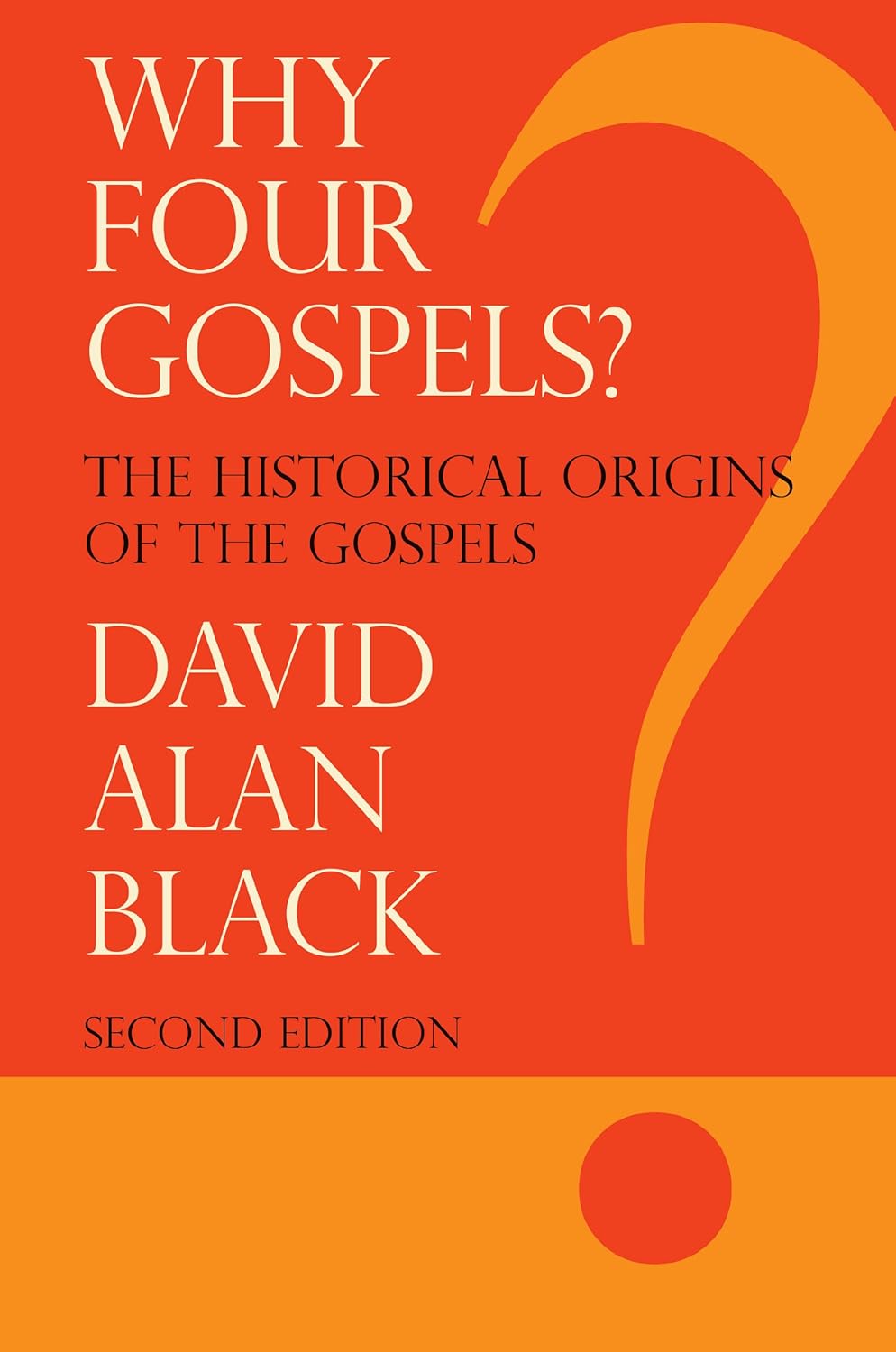Book review: Why Four Gospels? The Historical Origins of the Gospels
by David Alan Black
★★★★★
Very good. This is a concise, well-organized explanation of the historical and textual arguments for David Black’s Fourfold-Gospel Hypothesis and an early writing of the Gospels. It’s a conservative treatment; David’s purpose in writing is to “renew, restore, and strengthen faith in the truth of the Gospels by providing scientific support for the church’s continuous teaching on their apostolicity and historicity.
I have been looking for a simple guide to the argument for apostolic authority and the traditional ordering of the Gospels, and this one does the trick. Relying heavily on the testimony of the early church fathers, David presents a reasonable scenario for the development of the Gospels. It is not David’s claim that the fathers of the church solve the synoptic problem; it is that any approach that rejects their testimony is lacking. A hypothesis is needed that does justice both to critical scholarship and to the integrity of the church fathers.
Matthew’s Gospel came first, written in Greek. It was a response to a need within the early church (years 33-44) to preserve the story of Jesus. But Matthew’s version, while highly respected in Jerusalem circles, didn’t fit the bill for Gentile readers, and Paul commissioned Luke to rework the Gospel message for the benefit of his own Greek churches. Luke was able to “change the whole emphasis of the Gospel into a demonstration of the good fortune of the Gentiles in being given equality by Jesus with the original chosen people.”
Peter happened to be in Rome at the time of Paul’s captivity, so Paul met with Peter and asked his advice about Luke’s new gospel. Peter was happy to compare the two (Luke and Matthew), and since it was his plan to give a series of speeches in Rome, he took both together and, with Mark in attendance, fitted them into five lectures which Mark preserved in writing. These lectures are recorded in Mark 1:2-3:19, 3:20-6:13, 6:14-10:1, 10:2-13:37, and 14:1-16:8. Peter’s intent was to refer only to those portions of Jesus’ life of which he had been an eyewitness and could personally vouch for. Thus, there exists no birth stories or resurrection narratives in Mark.
Those who listened to Peter were delighted with what they heard, and requested from Mark copies of what Peter said. Peter allowed this, and Mark’s Gospel was birthed. The final twelve verses of the gospel (which are not in the earliest manuscripts) were surely added by Mark at a later date, when he decided to publish the gospel as an act of piety to the memory of Peter.
That’s the way David fits the puzzle pieces together, relying heavily upon the patristic evidence, and it explains the internal data “at least as well as the Markan priority hypothesis, and often much better.” It also explains the need for three Synoptic Gospels. David then goes pericope-by-pericope through the Gospels explaining how Mark was pieced together from Matthew and Luke, and while I didn’t take time to study his analysis, it’s nice to know he did his homework.
While I’m not a conservative believer and have no issue with Markan priority (as proposed by the popular solution to the synoptic problem), and while a number of issues remain unresolved (such as Matthew’s apparent familiarity with the events of 70 CE), I found this a very helpful review of the patristic evidence for traditional beliefs.












 354 Circles
354 Circles
 603 Goodreads Friends & Fans
603 Goodreads Friends & Fans

 Hello! I'm an author, historical Jesus scholar, book reviewer, and liberal Christian, which means I appreciate and attempt to exercise the humanitarian teachings of Jesus without getting hung up on any particular supernatural or religious beliefs.
The Bible is a magnificent book that has inspired and spiritually fed generations for thousands of years, and each new century seems to bring a deeper understanding of life’s purpose. This is true of not only Christianity; through the years, our age-old religions are slowly transforming from superstitious rituals into humanitarian philosophies. In short, we are growing up, and I am thrilled to be riding the wave.
I avidly read all thought-provoking religion titles. New authors: I'd love to read and review your book!
Hello! I'm an author, historical Jesus scholar, book reviewer, and liberal Christian, which means I appreciate and attempt to exercise the humanitarian teachings of Jesus without getting hung up on any particular supernatural or religious beliefs.
The Bible is a magnificent book that has inspired and spiritually fed generations for thousands of years, and each new century seems to bring a deeper understanding of life’s purpose. This is true of not only Christianity; through the years, our age-old religions are slowly transforming from superstitious rituals into humanitarian philosophies. In short, we are growing up, and I am thrilled to be riding the wave.
I avidly read all thought-provoking religion titles. New authors: I'd love to read and review your book!
 Hi! While Lee writes the articles and reviews the books, I edit, organize, and maintain the blog. The views expressed here are Lee's but I'm his biggest supporter! :-)
Hi! While Lee writes the articles and reviews the books, I edit, organize, and maintain the blog. The views expressed here are Lee's but I'm his biggest supporter! :-)
Looks like a good book. I have some issues with this argument, though: “Peter’s intent was to refer only to those portions of Jesus’ life of which he had been an eyewitness and could personally vouch for. Thus, there exists no birth stories or resurrection narratives in Mark.” The thing is, the other Gospels and Paul in I Corinthians 15 do present Peter as an eyewitness to the risen Jesus. So why would Mark leave that out, if he were recording what Peter could vouch for?
Yeah, I’m with you on that, I questioned it as well. Hope I didn’t misunderstand the author.